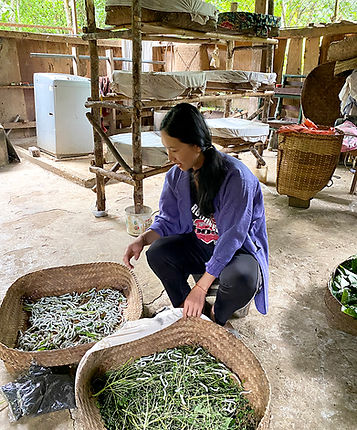Pick up
September 1, 2025
Not just beautiful
The world of Laos packed into Shin
◇Part 2◇
in Viengxay



The mulberry leaves that the silkworms left behind are planted and then new leaves are harvested.

Ms.Nui covers the silkworms with cloth and keeps them in a quiet environment. Approximately 2 kg of silk can be harvested from seven bamboo hooks.


Left: Shiny mulberry leaves that have just been harvested. Right: Silkworm droppings are sold as tea.

When I visited Viangxay Village in June 2025, I met people working in weaving, where the process begins not at the loom but with silkworms.
In one corner of the village lies an 1,800-square-meter mulberry field with 500 trees, certified by the United Nations Environment Programme in 2011. Today, it’s managed by the village, with seven households allowed to use it. Most silkworm eggs come from specialized suppliers in Vietnam.
Silkworms are surprisingly delicate and sensitive to smells—tobacco and perfume are out of the question. Wet mulberry leaves can’t be fed to them, and if even one silkworm dies, the whole bamboo basket must be disinfected with lemongrass or lime. It takes about 30 days for them to hatch and spin cocoons, a cycle repeated around seven times between March and October. Cocoon storage, reeling, dyeing, and weaving happen year-round.
Households take different approaches: some raise silkworms and sell threads, others handle the entire process to finished fabric, while some only weave with purchased yarn. Most women learn from their mothers—some as early as eight, most in their early teens. Patterns may be inherited, commissioned from specialists, or original creations.
While walking through the mulberry field, I met a woman scattering leftover leaves and stems at the base of the trees as fertilizer before picking fresh leaves. I was fascinated to learn that silkworm droppings can be sold as tea, and pupae as food—nothing here goes to waste.
Lao weaving, I realized, is more than history and tradition—it’s a living, sustainable process that points toward the future and the goals of the SDGs. The timeless appeal of handcrafted work—high in quality and rich in character—will always stir our admiration and continue to captivate us. Today, Viangxay is developing a “Weaving Tour,” which could become a favorite for visitors alongside its cave ruins and cherry blossom park.

Raw silk before dyeing. Apparently Vieng Xai silk is durable.


The thread-like guides that determine the weaving pattern are either vertical (left) or horizontal (right). Even after observing, we were left wondering how they were reflected in the work at hand.

Ms.Chittawan, who works at the store while weaving, began learning from her mother at the age of eight.

Ms.Santhone is an elementary school teacher who wants to teach weaving to children.

Ms.Wang works in a corner of the market, selling his products in the shop next door.

Ms.Oi holds an important position in the village and has advanced weaving skills.


When the silkworms start making cocoons, they are moved to a special bamboo mold (mabushi) and begin to spit out silk, resulting in the state shown on the right.

The pupa is removed and the thread is twisted into yarn.

Ms.Sam, who is always smiling, is a professional weaver. He can complete almost one piece in a week.

Ms.Penn is involved in all processes from sericulture to weaving. He also showed us the spinning tools.

It seems that chemical dyes, which can produce stable colors, are becoming mainstream.

Ms.Penwan is raising a child. Her daughter is also very interested in textiles.

Ms.Buaporn and his family also do all the processes. They are good at making colorful patterns.



The La family also participates in all processes. Their mother raises silkworms, while their sisters weave in two places on the premises. They also make their own patterns. At this time of year, they seem to have a lot of Shin parts.